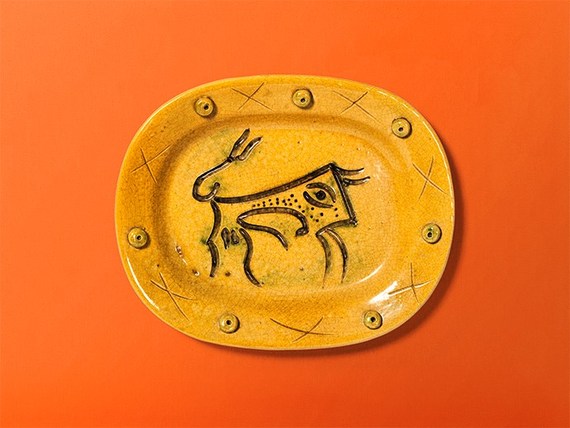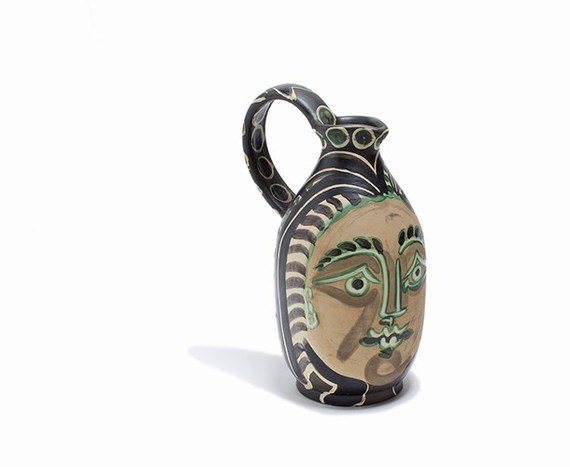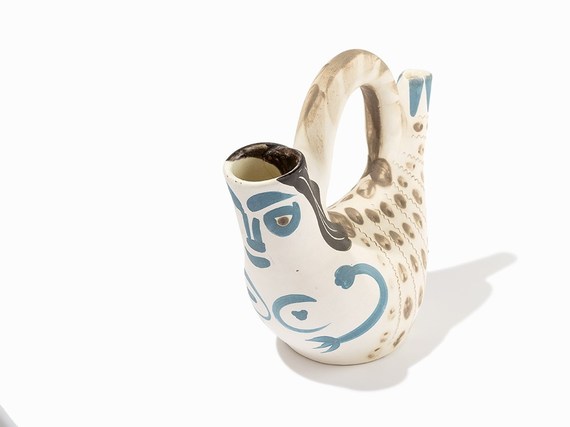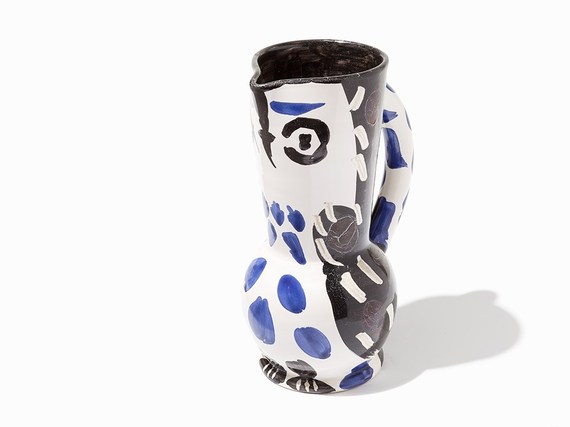Escaping the bustle of city life in Paris, Pablo Picasso visited the city of Vallauris in the South of France, where he would spend his summers and many of the happiest and most creative years of his life. Captivated by the annual ceramic festival in Vallauris, Picasso asked to be introduced to Georges and Suzanne Ramié, the creators of the works that were on display from the Madoura Pottery, and soon after began creating ceramics himself.
Picasso explored the possibilities of creating bold and colorful ceramic sculptures at Madoura Pottery, and a year after his first visit he dedicated himself to creating unique ceramics at Madoura. Picasso's ceramics were in a sense a liberation from his large, laborious paintings. He spent his time in the South of France relaxing, attending exciting bullfights, admiring the local animals, particularly his pet owl, and enjoying peaceful summers living the simple life of an artisan.
Picasso's ceramics reflect the fun and enjoyable atmosphere that he grew so fond of in Vallauris. He began creating hand painted bowls and plates; later he would create more intricate pieces, transforming pitchers into animals, and vases into life-like playful forms. His ceramics capture his time relaxing as a craftsman, using his hands and transforming the ordinary medium of ceramics, into the extraordinary.

Pablo Picasso, Tareau gravé, Ceramic Plate, 1947.
Photograph Courtesy of Auctionata, Picasso Ceramics Catalogue
Reinventing the craft
Picasso's intention was to create works that could be affordable and accessible to the public and his collectors. People would visit the South of France and purchase his beautiful ceramic pieces as souvenirs to use to fill up with wine or flowers.
Over the past ten years, the market for Picasso's ceramics has been continually booming. Picasso's ceramic pots, vases, plates and pitchers have garnered the attention of museum curators, major art collectors and auction house specialists. Picasso Sculpture at the Museum of Modern Art was a survey of Picasso's sculptural work, celebrating his unconventional mediums and highlighting his ceramic works.
Picasso was able to transform a form of art that his contemporaries considered a craft or low form of art, into one of the most sought-after works of art on the market. Picasso Sculpture at the Museum of Modern Art was a survey of Picasso's sculptural work, celebrating his unconventional mediums and highlighting his ceramic works. Picasso, the giant of the 20th century, ingeniously reinvented the way we look at ceramics. Before Picasso no one would think to transform a utilitarian bowl into an owl, or find a face in an ordinary pitcher.

Pablo Picasso, Femme du barbu, Ceramic Pitcher, 1953.
Photograph Courtesy of Auctionata, Picasso Ceramics Catalogue
A Hot Commodity
Picasso Ceramics are a very specific niche in the market that has continued to achieve high prices. Many auction houses have frequently dedicated entire sales to these works. For example, Auctionata, the leading online auction house, has a dedicated sale of Picasso ceramics, offering a wide range of pieces at approachable price points. Other auction houses, such as Sotheby's which recently held their sale, Picasso in Private: Works from the Collection of Marina Picasso, achieved record prices for the 20th century artist. Throughout the past ten years Picasso ceramics have become increasingly popular. Collectors have begun looking away from objects to hang on their wall, and have embraced these three-dimensional jugs, pitchers and pots.

Pablo Picasso, Figure de proue, Ceramic Pitcher, 1952.
Photograph Courtesy of Auctionata, Picasso Ceramics Catalogue
A Booming Market
The affordability of these ceramics has also been an attractive quality for both beginning and established collectors alike. As the prices of Picasso's paintings, prints and sculptures has continued to soar, many collectors have been "priced out" of owning a piece of this modern artist's oeuvre. For example, owning a painting or even a drawing of Picasso's from the 1940s could be cost-prohibitive to many collectors and lovers of Picasso. Therefore Picasso Ceramics, with their modest estimates, are a great way to own a piece of one of the most inventive and playful art forms, by one of the most esteemed artists in history.

Pablo Picasso, Cruchon hibou, Ceramic Pitcher, 1955.
Photograph Courtesy of Auctionata, Picasso Ceramics Catalogue